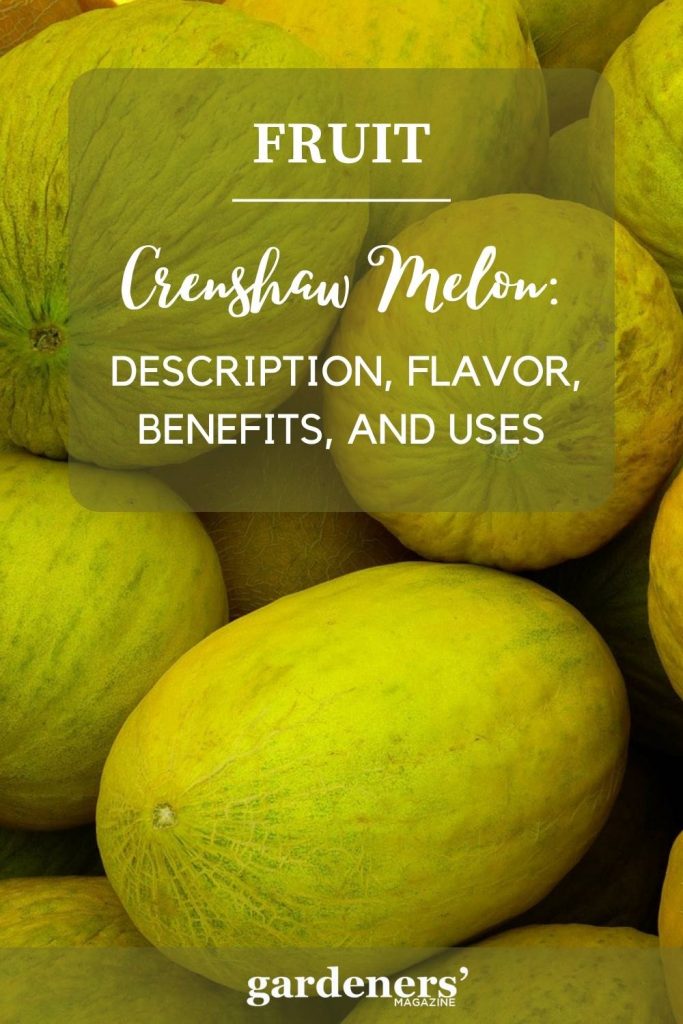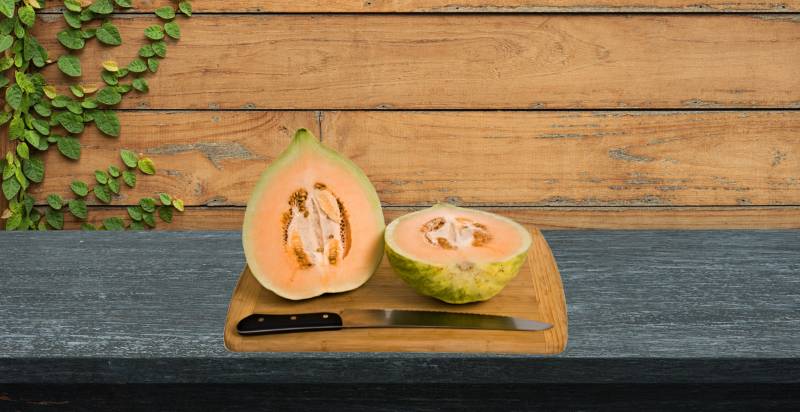The Crenshaw melon, also known as the Persian melon or Hales’ Jumbo Melon, is an heirloom melon found in the United States. It is a member of the Cucumis melo species, which includes muskmelons, cantaloupes, and honeydews. The Crenshaw melon is believed to have originated in India and was brought to the United States by African Americans in the mid-1800s. Cucumis melo is also one of the oldest cultivated plants, with evidence of its cultivation as far back as 4,000 B.C. Here’s what you need to know about the delicious Crenshaw melon.
What is Crenshaw Melon?
Crenshaw melons are large, oblong fruits with a yellow-orange rind and greenish-yellow flesh. The yellow rind is covered with a net-like pattern, which gives the melon its distinctive look. The flesh is sweet and juicy with an aroma similar to cantaloupe. The Crenshaw melon’s flavor is unique in its slight hint of honey and spice, making it a great addition to salads and salsas.

History and Origin of Crenshaw Melon
Crenshaw melon is an heirloom variety of melons originating in the United States. It was first grown in the late 1800s by William Crenshaw, who lived near Canton, Texas. The melon is known for its sweet taste and firm texture. Its flavor has been described as being similar to honeydew, with a hint of cantaloupe. Crenshaw melons are oblong and range from light green to yellow-orange when ripe. Its flesh is usually yellow or orange and very sweet.
Crenshaw melon is most commonly found during the summer months in the United States, particularly in Southern California, where it was first cultivated. It is also grown in other parts of California, Arizona, and Texas. The melon is often used for desserts such as pies, cobblers, and jams. It can also be eaten raw or served with salads or fruit platters. Crenshaw melons are a great source of vitamins A and C, potassium, and dietary fiber.
Today, Crenshaw melon is a popular choice for home gardeners and small-scale farmers. It is easy to grow and does not require any special care or attention. Its sweet flavor makes it the perfect addition to summer dishes and desserts. Crenshaw melon will surely please if you’re looking for a traditional treat or something unique.
Description of the Crenshaw Melon
The Crenshaw melon is a large, oval-shaped variety of melon. It typically ranges from 10 to 20 cm long and 8 to 16 cm wide. Its skin is smooth, waxy, and bright yellow when ripe, with localized areas of green netting. The flesh is juicy and sweet, with an orange-yellow color. This variety is best eaten when fully ripe. It is a popular choice for salads, fruit platters, and desserts.
Flavor Profile of Crenshaw Melon
The Crenshaw melon has a complex flavor profile. It is sweet and juicy, with honeydew, cantaloupe, and pineapple notes. There are also floral undertones that give the melon its unique taste. The fruit can range from pale yellow to dark green depending on ripeness and has smooth cream-colored flesh.
Health Benefits of Crenshaw Melon
Crenshaw melons are a great source of several essential vitamins and minerals. The fruits contain high levels of vitamin C, which helps to support the immune system and keep skin healthy. They also contain fiber, potassium, magnesium, and folate – all contributing to overall health. Crenshaw melons are a low-calorie food that can help you maintain a healthy weight.
Eating Crenshaw melons can also help lower your risk of diseases like heart disease and cancer. Lastly, the fruits contain various antioxidants that can enhance skin health and reduce inflammation. Crenshaw melons provide various health benefits and are a great addition to any diet.
Cultivation of the Crenshaw Melon
Crenshaw melons are usually planted from mid-May in areas of the United States with a growing season long enough for the fruit to mature in late summer. Depending on the variety, melon seeds should be sown 1⁄2–1 inch deep and spaced 18–36 inches apart. The soil should be well-drained and rich in organic matter. There should also be adequate irrigation when the soil is dry, and temperatures are warm.
Before planting, a soil test should be conducted to determine nutrient levels and pH. If necessary, lime can be added to raise the soil pH, and fertilizers can supply essential nutrients. During the growing season, melons need 1–2 inches of water per week, especially during periods of rapid growth.
Crenshaw melons can be susceptible to various pests and diseases, including powdery mildew, cucumber beetles, aphids, and root-knot nematodes. Appropriate controls are needed to protect the crop from damage. Properly managing weeds is also important to prevent competition for water and nutrients. Mulches and crop rotation can also help improve the health of melon plants.
Harvesting of the Crenshaw Melo
The Crenshaw melon is generally harvested when it reaches full maturity. This usually happens about 3 to 4 weeks after flowering. When harvesting, the stem should be cut cleanly near the base of the fruit, leaving a 1-inch portion attached. Care should also be taken not to damage or bruise the rind during harvest. After harvesting, they should be handled carefully to prevent further damage and stored in temperatures between 55-60°F (13-16°C).
The melons should be placed in a single layer on paper towels or newspapers to ensure optimal ripening. Fruit harvested earlier can also be allowed to ripen off the vine for several days before consumption. The Crenshaw melon is ready for consumption once the rind turns a yellow-green color and when the stem end yields to gentle pressure. The flesh should be creamy and sweet with a pleasant aroma.

Where Does Crenshaw Melon Grow?
Crenshaw melons grow mainly in the warm climates of the southern United States, Mexico, and parts of Central America. It can be found in the US in California, Arizona, Louisiana, Texas, and Florida. It is also grown in some places throughout Europe and Australia. The melon needs plenty of sunshine and heat to mature properly. While they are usually harvested in the summer, they can ripen in any season.
Crenshaw melons require well-draining soil with plenty of organic material to grow best. The plants need full sun and regular watering (every 3–4 days) to ensure their growth and fruit production. They are generally grown in mounds or raised beds that help with water retention, as the plants are highly susceptible to rot if they stay wet for too long. Additionally, farmers will use trellises or supports to keep the melons off the ground and away from pests and diseases.
What are the things you need to keep in mind when Buying Crenshaw Melon?
- Look for medium to large melons, firm and heavy for their size.
- Check the skin of the melon; it should be deep yellow or golden with dark green stripes or mottling near the stem area and over the blossom end.
- The stem should still be attached and look fresh and green.
- Avoid melons with soft spots, bruises, cuts, or mold on the skin.
- When you press your thumb into the blossom end of the melon, it should give slightly; if it’s too hard, it means it’s not ripe yet, but if it gives too much, it is overripe.
- Lastly, the melon should emit a sweet, musky aroma. There are many varieties of Crenshaw
Melon, and some have unique aromas that you can use to indicate ripeness.You’ll surely get the best quality and flavor by following these simple tips when buying Crenshaw Melons.
What is the Best Way to Store Crenshaw Melon?
The best way to store Crenshaw Melon is to keep it in a cool, dark place. The temperature should be between 55-65°F with relative humidity of 50-80%. Store the melon away from other fruits and vegetables as they can emit ethylene gas which can cause premature ripening. The melons should also be stored on a shelf or other raised surface to keep them off the floor and away from any potential sources of moisture or contamination. Once cut, store the melon in a sealed container in the refrigerator for up to a week.
How can Crenshaw Melon be used in Recipes with other Fruits and Vegetables?
Crenshaw melon can be used in various recipes, from salads to smoothies. Combined with other fruits and vegetables, it adds a unique flavor and texture to dishes. Combine Crenshaw melon cubes with cucumber slices, feta cheese, and a light vinaigrette dressing for an easy salad. Or use the melon in a smoothie with other favorite fruits, like bananas and strawberries.
Try drizzling honey over the top to give your recipes an even sweeter taste. For a savory dish, add cubes of Crenshaw melon to stir-fries and curry dishes for a sweet burst of flavor. You can also puree the melon as a sauce or topping for desserts. With its unique flavor, Crenshaw melon can be used in various recipes to create delicious dishes that will impress.
Conclusion
Crenshaw Melon is a delicious, sweet melon with a distinct flavor that can be used in many recipes. When selecting Crenshaw Melon, look for melons that are heavy for their size and have a sweet aroma. To store the melon, keep it in a cool, dry place below 75°F with a relative humidity of 50-80%. For best results, store cut melons in a sealed container in the refrigerator. Crenshaw Melon can add flavor and texture to salads, smoothies, stir-fries, and more. With its unique taste, it’s sure to become a favorite addition to your recipes!
- Everything You Wanted to Know About Red Tamarillos - June 2, 2025
- A Guide to Tulips: Everything You Need to Know & More… - June 2, 2025
- Guanabana: Description, Flavor, Benefits, And Uses - May 27, 2025

1 thought on “Crenshaw Melon: Description, Flavor, Benefits, And Uses”
Comments are closed.